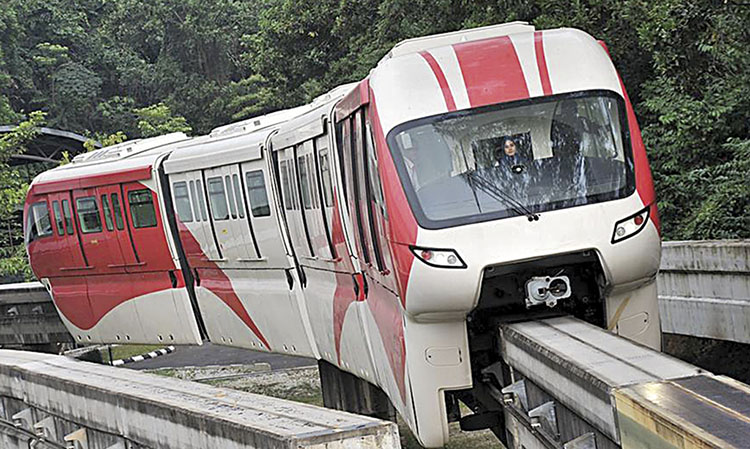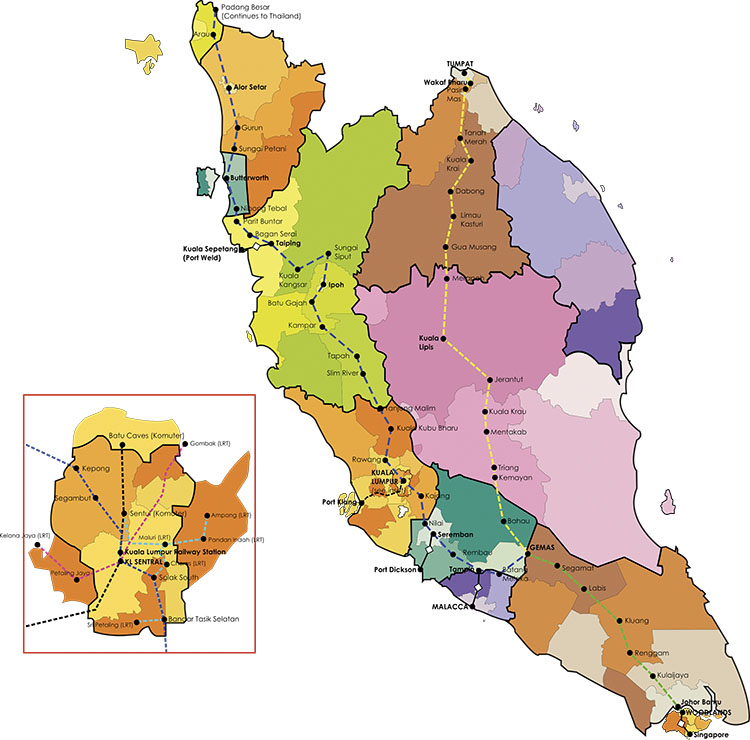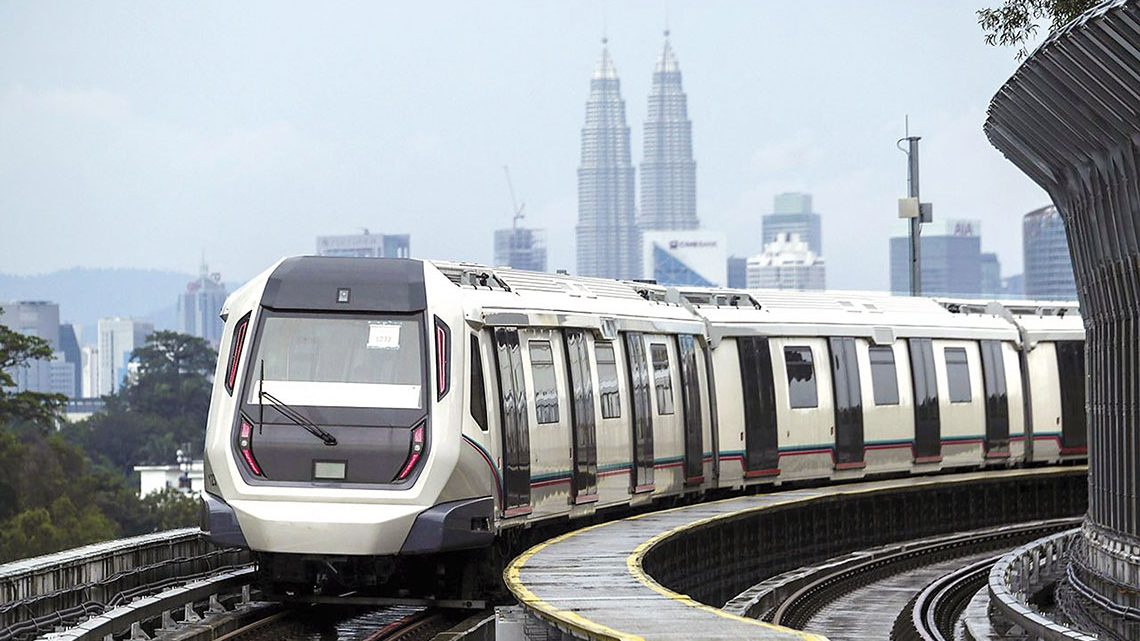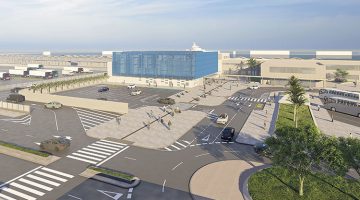Malaysia, situated in the centre of Southeast Asia, one of the world’s most dynamic regions, divides its territory between the Malay Peninsula, where its capital Kuala Lumpur is located, and the less populated island of Borneo in the north. The country, which has opted for a free market economy with intensive use of technology and capital, is in the middle of the ranking in terms of global development and aspires to advance further in the coming years by diversifying its economy –its services sector now represents more than 55% of its GDP– and investing heavily in infrastructure, especially in transport. The goal is to expand and improve its road and rail networks with projects such as the Pan Borneo highway, new metro lines in Kuala Lumpur and a high-speed rail link to Singapore, among other projects.
The rail network, including urban, commuter and long distance, is essential for the transportation of people and freight in this country of 32 million inhabitants with a high population density –97 inhabitants per km2– especially concentrated in the metropolitan and surrounding areas of the capital. Because of this, the government has implemented plans to promote the use of public transport, proposing, along with the heavy investments in infrastructure, the application of a new open-access model of rail transport operation, to replace the current ‘vertical integration.’

The Petronas Towers.
The open-access model in rail transport, through different governance schemes, is currently being applied in the European Union and other countries around the world. The model is based separating ownership and management of the railway infrastructure from operation, allowing different operators that comply with the established regulations to provide these services, thereby increasing competition and efficiency of the service. The model also includes the creation of a sole infrastructure authority and rail transport regulator which defines the technical and economic conditions for the granting of licences (as infrastructure managers or operators), establishes a system of incentives and penalties for operators and is responsible for safety certification.
The open-access model: Main proposals

The monorail runs for some 9 km in the centre of Kuala Lumpur. It has 11 stations and approximately 68,000 users per day.
- In the proposed system, the SPAD would act as the sole authority for controlling and monitoring of the railway infrastructure and market and technical regulator, and, would therefore, be responsible for granting manager and operator licences. This would require legal reforms.
- Changes to the governance structure: Ineco’s analysis includes two options: one, to transfer the personnel, resources, much of the equipment and competencies in the field of infrastructure management from KTMB to RAC, which would become the owner and manager. However, given the complexity of the implementation of the aforementioned system, a second option has been proposed: RAC, which currently owns the infrastructure, would transfer its infrastructure operation to KTMB, or an independent third party, in exchange for an availability charge, and would keep the activities that are not strictly rail related, such as commercial development, property assets, broadband, car parks and advertising. The funds raised would mainly be used to reduce the availability charge. According to the proposed system, relationships between infrastructure managers and operators would be defined through contracts under the supervision of SPAD and between the operators and the government, in the event that the latter has to provide financing of services of public utility, but not for profit, with the appropriate control mechanisms.
- Establishment of capacity allocation mechanisms: this is a vitally important process for the proper functioning of a railway transport open-access model, and is carried out in two phases: reservation and allocation. First, the infrastructure manager will accept, in principle and on a provisional basis, all requests from operators for which there is available capacity. The final decision on the allocated routes must be justified by the manager and subject to SPAD’s power to resolve disputes. Second, an annual schedule will be designed, subject to monthly, weekly and daily adjustments, to allocate reserved capacity and requests on specific routes. For the allocation of routes, criteria of free competition and certainty for operators will be applied, without undermining operational management.
- Charges to operators: the definition of the correct economic model is considered crucial for a successful outcome of rail transport open access. The proposal in the case of Malaysia is a dual approach to charging for track access: one for freight and the other for passengers. Both consist of three charges: one for reservation and capacity, another for circulation and the third for traffic, all calculated according to the infrastructure owner’s cost structure (the study includes a preliminary schedule). In addition, other charges will be established for ancillary services and use of facilities such as passenger stations, car parks, platforms, loading points and sidings.
- Implementation of a system of incentives and penalties: the aim of the performance management system is to promote the quality and punctuality of the service provided by the operators, as well as the quality and availability of the infrastructure managers.
- Safety and interoperability: it is necessary to create an infrastructure register and a vehicle register, as well as a body for the entire Malaysian network responsible for studying the causes of accidents and issuing recommendations. This function could be carried out by an independent department within SPAD or by an independent national investigation body. In addition, both managers and operators must develop a safety management system defined by SPAD. In terms of interoperability on international routes, SPAD will also be responsible for defining the technical specifications and unifying the technical parameters to allow authorisation for the operation of a foreign train within the Malaysian network. To do so, SPAD will need to sign mutual recognition protocols with the competent authorities of other countries and agreements to detail the specific requirements.
- PESTLE analysis: this type of analysis studies the influence of political, economic, social, technological, legal and environmental factors on a project. It is considered necessary for the regulatory impact assessment which must be carried out by the public authority before new regulations are included. Regarding political aspects, the conclusions of the analysis indicate that the new railway management model will contribute to improving organisational structure, reducing uncertainties and organising and clarifying the functions of the key stakeholders.
With regard to economic aspects, the introduction of free competition with new operators is expected to contribute to economic growth by increasing the competitiveness and productivity of companies and users, and reducing travel times and costs. It will also offer more reliable and higher quality transport. From the social point of view, the expected growth of the Malaysian population means that mobility needs to be improved. Regarding technological aspects, the new operators could introduce innovative technical solutions. In the legal field, the most important change will be the implementation of an unbundling a rail transport model in the peninsular network, with the respective capacity and load allocation mechanisms required. The main legislative changes will be established in an amendment to the current Land Public Transport Act 2010. SPAD must be empowered to grant licences and implement regulations related to infrastructure. Finally, in relation to environmental factors, the proposed model adopts the proposals of Malaysia’s National Master Plan for Land Public Transport, which is committed to public transport, and rail in particular, in order to reduce pollution and congestion. The Plan aims to double the country’s modal share of public transport to 40% by 2030. - Business sustainability report: the study also includes a report in which a general estimate is made of the system’s revenue and cost schedule to ensure its sustainability once the open-access model is implemented.
RAILWAY REGULATION EXPERTS
Ineco, in consortium with the Spanish railway infrastructure manager Adif and the Malaysian companies HSS Integrated and Wong & Partners (Baker & McKenzie International), has drafted a project for implementing the open-access framework in Malaysia’s railways for SPAD (Land Public Transport Commission). Ineco has been providing expert advice to the Spanish government for many decades in connection with the reform of the rail sector after Spain joined the European Union in 1986. In Spain, the separation of railway infrastructure management and operation took place in 1995 with the creation of Adif and Renfe Operadora, as a result of the entry into force of the Railways Act, which Ineco helped the Ministry to draft. Internationally, in 2014, the company prepared a project to implement an open-access model for Brazil’s railways.
The project for Malaysia’s railways involved an analysis of the organisational, technical and economic/financial aspects, and contains recommendations for overhauling the complex legislative and institutional framework of the country’s rail sector. Rail transport responsibilities in Malaysia are currently divided among several bodies and entities under three different ministries. In 2010, with the entry into force of a new Land Public Transport Act, a new body, SPAD, was created under the auspices of the Prime Minister’s Department to improve coordination and promote the use of public transport. SPAD (Suruhanjaya Pengangkutan Awam Darat, in Malaysian, Land Public Transport Commission) took over the planning and regulation of the railways (and some bus lines, such as route concessions). At the same time, the public enterprise KTMB, under the Ministry of Finance, is the operator of the peninsular suburban, interurban and freight line network, while infrastructure development is the responsibility of the Ministry of Transport through RAC (Railway Assets Corporation). In terms of light rail and metro, the public corporation Prasarana is both owner and operator of the Light Rapid Transit (LRT), Mass Rapid Transit (MRT) and Kuala Lumpur monorail systems, as well as operator of bus lines in three other cities in the country. Against this backdrop, the proposed open-access model will be applied to the operation of the current KTMB network, with the exception of suburban services. Prasarana’s metropolitan network will however be excluded from the new plan (the sole operator would remain and two licences would be granted: operator and manager), as will two public-private partnership (PPP) concession and association projects that are currently underway in the country: the future Malasia-Singapore high-speed line (for which Ineco conducted a demand study in 2014, also for SPAD) and the East Coast Rail Line (ECRL). The legal framework of both projects will not be amended, it has been proposed that the infrastructure manager should apply for the corresponding system manager and operator licence.
Peninsular railway network
Malaysia is divided into a peninsular region, where 80% of the population is concentrated, and the sparsely-populated region of the island of Borneo in the north. The rail network totals about 2,500 kilometres. Two long-distance lines run from north to south on each coast. The capital and its metropolitan region have commuter, metro, monorail and light rail services.







